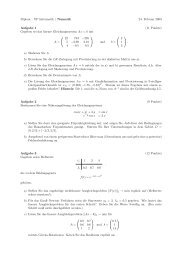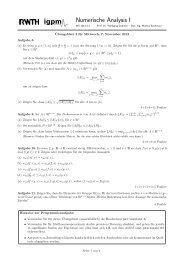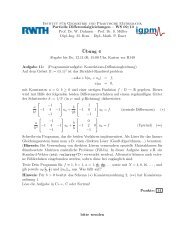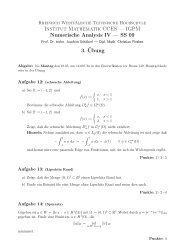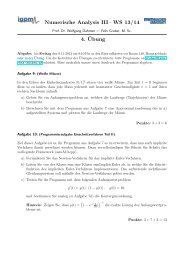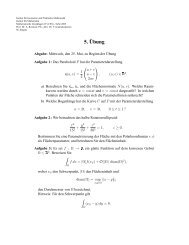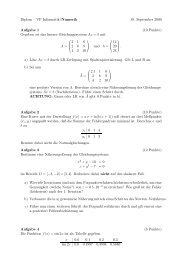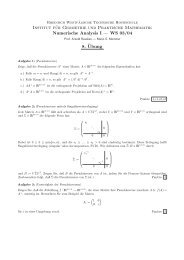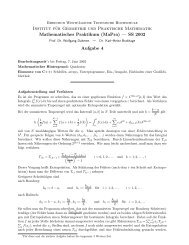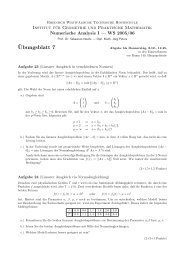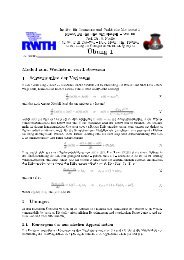Variable-step preconditioned conjugate gradient method for partial ...
Variable-step preconditioned conjugate gradient method for partial ...
Variable-step preconditioned conjugate gradient method for partial ...
You also want an ePaper? Increase the reach of your titles
YUMPU automatically turns print PDFs into web optimized ePapers that Google loves.
Theorem 1 shows that a certain sequence {x (i)<br />
j } ∈ A−i V converges to eigenvectors uj when<br />
i → ∞. However, it does not address the behavior of the sequence {v (i)<br />
j<br />
by Algorithm SUBIT. Really, due to the optimality of x (i)<br />
j<br />
slowly than x (i)<br />
j<br />
} actually computed<br />
the approximations v (i)<br />
j<br />
converge<br />
. Likely, the following Theorem 2 shows that v(i) j converge to x (i)<br />
j at the same<br />
to uj, and hence, the same convergence factor (λj/λm+1) i governs the<br />
asymptotic rate as x (i)<br />
j<br />
linear convergence of approxmated eigenvectors v (i)<br />
j to the actual eigenvectors uj.<br />
Theorem 2 [27] When subspace iteration uses Algorithm SUBIT then each Ritz vector v (k)<br />
i<br />
related to the vector x (k)<br />
i of Theorem 1 as k → ∞, by<br />
sin ∠(v (k)<br />
i , x (k)<br />
�� i ) = O<br />
λi<br />
� �<br />
k<br />
, i = 1, 2, . . . , m.<br />
λm+1<br />
On the other hand, one can measure the deviation of the subspace V and U from Theorem 1<br />
through the classical definition of the distance between equidimensional subspaces, see [10], <strong>for</strong><br />
example. Using this definition the number of interesting results has been obtaind by D’yakonov,<br />
Knyazev et al. [4, 5, 6, 11, 12, 13] <strong>for</strong> symmetric positive definite matrices under the natural<br />
assumption on the <strong>preconditioned</strong> matrix MA, i.e., there exist two positive constants c0 and c1<br />
such that<br />
0 < c0(M −1 v, v) ≤ (Av, v) ≤ c1(M −1 v, v) <strong>for</strong> all v ∈ R n .<br />
The main convergence result <strong>for</strong> SUBIT <strong>method</strong> can be written as follows<br />
λ (i+1)<br />
j<br />
− λj<br />
λj+1 − λ (i+1)<br />
j<br />
i<br />
λ(0) j − λj<br />
≤ (1 − ξ)<br />
λj+1 − λ (0)<br />
j<br />
, ξ = c0<br />
c1<br />
· λn<br />
λm+1<br />
· λm+1 − λj<br />
.<br />
λn − λj<br />
Clearly, the present estimate is not as sharp as one in Theorems 1 and 2 and moreover, depends<br />
on the mehsize h as λn/λm+1.<br />
Finally, <strong>for</strong> the completeness of the presentation we give a short description of the Rayleigh-<br />
Ritz projection. It is well-known that Ritz projection computes the best set of approximated<br />
eigenvectors from a subspace to eigenvectors of the original matrix A [27]. Here we use them to<br />
find all eigenvectors from the subspace spanned onto computed approximations w (k)<br />
1<br />
is<br />
, . . . , w(k)<br />
m . As<br />
a result we get a number of orthonormal approximated eigenvectors and their eigenvalues. Here<br />
we present only the basic <strong>step</strong>s of the <strong>method</strong><br />
Algorithm RITZ<br />
Input: p starting vectors ˆv1, . . . , ˆvp<br />
Devices: to compute Av <strong>for</strong> a given vector v<br />
to compute the scalar product (v, u) <strong>for</strong> given vectors v and u<br />
to compute the orthonormal basis <strong>for</strong> given vectors<br />
to compute the eigenvalues and eigenvectors <strong>for</strong> a given matrix<br />
Method: 1 Orthonormalize the vectors {ˆvi} p<br />
i=1 and <strong>for</strong>m n-by-p matrix<br />
W = [w (k)<br />
1 , . . . , w(k) p ] from new orthonormal vectors {w (k)<br />
i }pi=1<br />
2 Compute scalar products hij = (w (k)<br />
j , Aw (k)<br />
i ) and<br />
<strong>for</strong>m p-by-p matrix H = {hij} = W T AW<br />
3 Compute all eigenpairs of H: Hui = µiui, i = 1, . . . , p<br />
4 Compute all Ritz vectors vi = W ui, i = 1, . . . , p.<br />
Output: the approximations µj and vj to the smallest eigenvalues λj<br />
and corresponding eigenvectors uj, j = 1, . . . , p.<br />
5



